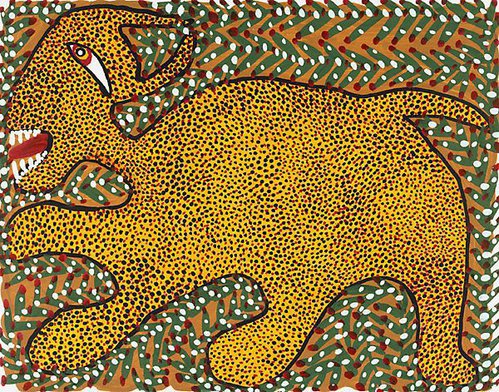-
Details
- Place where the work was made
-
Rajasthan
→
India
- Cultural origin
- Pauva caste, also known as Jogi or Bharathari
- Date
- 1992
- Media category
- Painting
- Materials used
- poster colour on paper
- Dimensions
- 152.2 x 196.7 cm
- Signature & date
Not signed. Not dated.
- Credit
- Purchased 1993
- Location
- Not on display
- Accession number
- 351.1993
- Copyright
- © Teju
- Artist information
-
Teju Ben
Works in the collection
- Share
-
-
About
The original inhabitants of India are most correctly described by the umbrella term Adivasi. Under this term a large number of communities exist with different social, religious and artistic practises.
Teju Ben belongs to the Pauva caste, also known as Jogi or Bharathari. Traditionally their profession was to wake people at dawn, by singing. Painting was done directly onto the walls of domestic dwellings and Teju Ben is well known for her many murals on cow-dung and clay walls in Delhi and Udaipur.
As a response to drought and wide spread changed living conditions during the early 1980s the Bharat Bhavan arts centre located in Bhopal, Madhya Pradesh encouraged local and international curators and artists to visit Adivasi communities as a way of promoting their cultural practises. This acted as a catalyst for many Adivasi painters who found new subjects and mediums for painting.
Around the same time many people like Teju Ben and her husband Ganesh moved to urban environments in search of better living conditions. After moving from their rural home in Rajasthan to the neighbouring state of Gujarat, the couple resettled in its capital, Ahmedabad where they had a chance meeting with the esteemed Baroda School painter, Haku Shah. Haku Shah first encouraged the couple to return to singing as a source of income and later to take up drawing and painting.
Teju Ben first began drawing on paper and first showed her works on paper in 1985 at the Crafts Museum in Delhi and soon after began making large scale mural paintings. She often portrays herself in her work and is directly inspired by the things around her, her house, children and Hindu beliefs. While Teju Ben's art does not derive from a particular 'Adivasi' style, it nevertheless displays influences from Rhajastani painting and represents a contemporary style of folk painting.
-
Exhibition history
Shown in 2 exhibitions
India Songs, Art Gallery of New South Wales, Sydney, 01 Apr 1993–09 May 1993
India Songs, Wollongong Art Gallery, Wollongong, 15 May 1993–12 Jun 1993
India Songs, Orange Regional Gallery, Orange, 25 Jun 1993–31 Jul 1993
India Songs, Canberra School of Art Gallery, Canberra, 05 Aug 1993–04 Sep 1993
India Songs, Campbelltown Arts Centre, Campbelltown, 17 Sep 1993–24 Oct 1993
Indian Folk Paintings and Textiles, Art Gallery of New South Wales, Sydney, 29 May 2004–04 Jul 2004
-
Bibliography
Referenced in 2 publications
-
Victoria Lynn, India Songs: multiple streams in contemporary Indian art, Sydney, 1993, 48, 54. cat no. 56
-
Alan Mascarenhas, Sydney Morning Herald, "Grains of lives sewn at the margins', pg. 16, Sydney, 28 May 2004, 16 (illus.). Image partially displayed only
-


